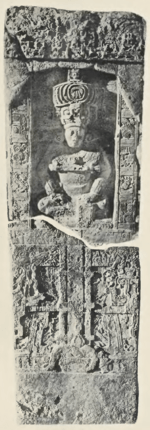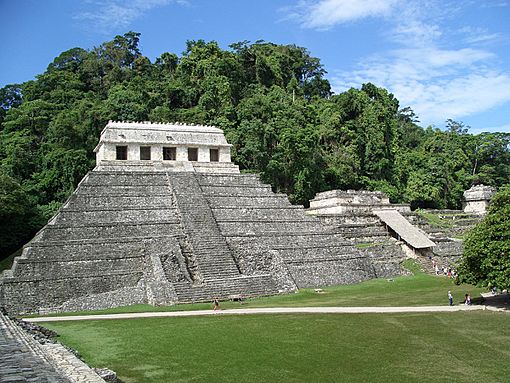Itzam Kʼan Ahk II facts for kids
Quick facts for kids Itzam Kʼan Ahk II |
|
|---|---|
| Ajaw | |

Itzam Kʼan Ahk II's portrait on Stela 11
|
|
| King of Piedras Negras | |
| Reign | 9 November 729 - 26 November 757 |
| Predecessor | Kʼinich Yoʼnal Ahk II |
| Successor | Yoʼnal Ahk III |
| Born | 18 November 701 |
| Died | November 26, 757 (aged 56) Piedras Negras |
| Issue | Yoʼnal Ahk III Haʼ Kʼin Xook Kʼinich Yat Ahk II |
| Religion | Maya religion |
| Signature | |
Itzam Kʼan Ahk II (born November 18, 701, died November 26, 757) was an important ruler, known as an ajaw, of Piedras Negras. This was an ancient Maya city in Guatemala. He ruled during the Late Classic Period, from 729 to 757 AD. Itzam Kʼan Ahk II became king after Kʼinich Yoʼnal Ahk II passed away. He might have been the father of the next three kings of Piedras Negras: Yoʼnal Ahk III, Haʼ Kʼin Xook, and Kʼinich Yat Ahk II. After Itzam Kʼan Ahk II's death, Yoʼnal Ahk III took the throne in 757 AD. Itzam Kʼan Ahk II left behind many important structures. These include large stone monuments called stelae at Piedras Negras. He also had a big burial temple, now called Pyramid O-13. His life story and a special celebration were carved on Panel 3. This panel was put up by Kʼinich Yat Ahk II years after Itzam Kʼan Ahk II died.
Contents
Itzam Kʼan Ahk II: His Life and Rule
Early Life and Family Connections
Itzam Kʼan Ahk II, also known as Ruler 4, was born on November 18, 701 AD. This date is recorded in the Long Count as 9.13.9.14.15 7 Men 18 Kʼankʼin. Interestingly, none of the records about his birth mention his parents. This suggests he might not have been the direct son of Kʼinich Yoʼnal Ahk II.
However, experts Simon Martin and Nikolai Grube found clues about his royal background. One carving shows him with a turtle ornament on his belt. This might mean one of his ancestors had "turtle" (auk) in their name. This would connect him to the royal family.
Another monument, Stela 40, shows a woman in clothing from Teotihuacán. She might be Itzam Kʼan Ahk II's mother. This could mean he wanted to highlight his family ties to Teotihuacan. This stela was also put up about 59 years after Itzam Kʼan Ahk I died. This suggests a special connection between the two rulers.
Becoming King and Celebrating His Reign
Itzam Kʼan Ahk II became ruler on November 9, 729 AD. This date is 9.14.18.3.13 7 Ben 16 Kʼankʼin in the Long Count. In 749 AD, he celebrated a special event called a Kʼatun jubilee. A Kʼatun is a period of 20 years in the Maya calendar. Many important guests attended this celebration. One guest was Kʼan Moʼ Teʼ, a high-ranking official who had served the previous king.
The details of this celebration were later carved on Panel 3. This panel was created by Kʼinich Yat Ahk II, the last ruler of Piedras Negras. The carving shows Itzam Kʼan Ahk II giving a speech to Yopaat Bahlam II. Yopaat Bahlam II was a temporary ruler of Yaxchilan. This panel suggests that Piedras Negras was more powerful than Yaxchilan during Itzam Kʼan Ahk II's time. A few days after the Kʼatun celebration, Itzam Kʼan Ahk II performed a "descending macaw" dance. Afterward, a drink made from fermented cacao beans was shared with his guests.
Warfare and Dominance
Itzam Kʼan Ahk II likely led his kingdom in wars. A special disc made of pyrite was found in his tomb. It shows the head of a leader from Hix Witz. Experts believe Hix Witz was under the control of Piedras Negras. This is supported by Panel 7, made by Itzam Kʼan Ahk I. It describes Hix Witz as a place that paid tribute to Piedras Negras.
The End of His Reign
Itzam Kʼan Ahk II's rule was known for its "hegemony" or strong control over nearby kingdoms. He died on November 26, 757 AD. This date is 9.16.6.11.17 7 Kaban 0 Pax in the Long Count. He was buried three days later. Panel 3 says his burial took place at a special "mountain" called ho janaab witz. This name referred to Pyramid O-13.
Yoʼnal Ahk III became the next king on March 10, 758 AD. The kings who followed Itzam Kʼan Ahk II honored his burial site. This makes some experts think that Itzam Kʼan Ahk II started a new ruling family. They believe the next three kings—Yoʼnal Ahk III, Haʼ Kʼin Xook, and Kʼinich Yat Ahk II—were his sons.
Important Monuments of Itzam Kʼan Ahk II
Stelae: Stone Records of His Rule
Itzam Kʼan Ahk II created at least five large stone monuments called stelae. These are Stelae 9, 10, 11, 22, and 40. Stelae 9, 10, and 11 were placed near Structure J-3.
Stela 11 was built in August 731 AD. It shows the ruler sitting in a small carved space, like a niche. This monument celebrates Itzam Kʼan Ahk II becoming king. The stela shows him surrounded by people who witnessed the ceremonies. The area in front of the stone was likely used for offerings and prayers. It also shows a scene of human sacrifice near the bottom.
When explorer Teoberto Maler found Stela 11, it was in two pieces. The front part was well-preserved, even showing some original colors. However, the carvings on the top right were worn away. In the 1960s, looters broke the monument into smaller pieces. This made it easier for them to illegally take it from the site. The top part is now in the Museum of Fine Arts, Houston. The bottom half is in a private collection in Switzerland.
Stela 9 was already broken into three pieces when Maler found it in 1899. The pieces were a bit worn, but the base was later found in its original spot by the University Museum. In the 1960s, looters took parts of this monument too, including a section showing a captive. Stela 10 is very worn, so many details are lost. Its head ornament is also missing.
Stela 22 was placed in the East Group Plaza, in front of Structure O-12. This made the East Group Plaza an important place for sculptures. While earlier stelae faced other directions, Stela 22 faced northwest. This created a new connection across the city.
Stela 40 shows the woman dressed in Teotihuacan clothing. It shows Itzam Kʼan Ahk II scattering something, possibly blood or incense. He is doing this into a "psychoduct." This is a special vent that leads to a tomb below the plaza. Simon and Grube suggest this shows a connection between the living and the dead. The woman on the stela, marked by an "upside down vase" symbol, is likely Itzam Kʼan Ahk II's mother. This monument shows Itzam Kʼan Ahk II's loyalty to a female ancestor.
Pyramid O-13: A Royal Burial Site

Pyramid O-13 is believed to be the burial temple of Itzam Kʼan Ahk II. According to Stephen Houston and his team, it was almost "twice as large" as any previous buildings in Piedras Negras. The pyramid was changed a lot after Itzam Kʼan Ahk II died. For example, Kʼinich Yat Ahk II moved an older Panel 2 and added Panel 1 and the famous Panel 3. Megan O'Neil believes these changes were made to connect the current ruler with the past. The last known rulers of Piedras Negras placed their stelae near this pyramid. All three of these leaders also saw the site as a special family shrine. This makes it possible that they were Itzam Kʼan Ahk II's sons.
In 1997, Héctor Escobedo found a tomb, called Burial 13. It contained the bodies of an adult and two teenagers. It was located under the plaza floor at the front of the pyramid's stairs. Some people think this was Itzam Kʼan Ahk II's resting place. However, Stephen D. Houston warns that this has not been fully proven. Many items were found inside, including jade pieces and ornaments. Archaeologists also found signs that the tomb had been opened again after it was sealed. Many bones were missing, and the skeletons seemed to have been burned after their first burial. Scholars later realized this was not a desecration. It was part of a ritual described on Panel 3 called el naah umukil, or "the house-burning at the burial." This ritual was carried out by Kʼinich Yat Ahk II.
Pyramid O-13 and the Temple of the Inscriptions at Palenque are very similar in their design. Both have the same number of terraces. Both pyramids have exactly five doors in their main structure. Both were built into the sides of hills. Damien Marken and Kirk Straight use these similarities, along with carvings at Palenque, to suggest a connection between Piedras Negras and Palenque.
See also
 In Spanish: Itzam Kʼan Ahk II para niños
In Spanish: Itzam Kʼan Ahk II para niños

